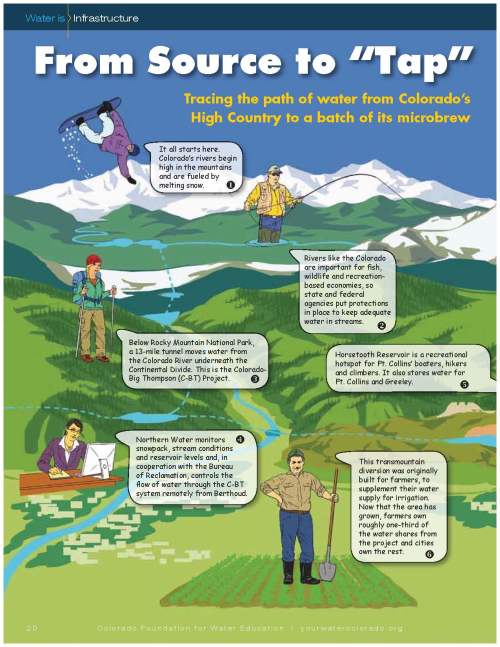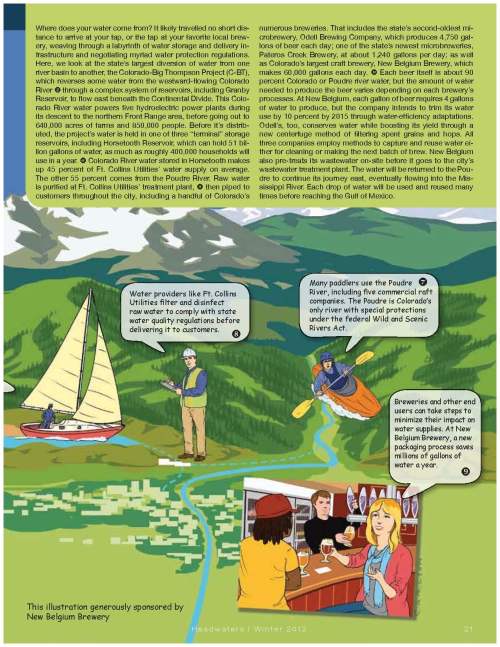Today, an NBC News story No Water, No Beer takes us back to last year’s bottled beverage tour, where 50 participants visited and heard from MillerCoors, MolsenCoors, Coca Cola and Nestle Water– companies who use Colorado’s water in beverage production. We toured the production plants, learned about water use and treatment, and heard about efficiencies and water conservation efforts. Of course, these bottled beverage companies rely on the same water that we all use to meet many demands in Colorado. From the NBC story:
“Without water, there is no beer,” Kim Marotta, the sustainability director for MillerCoors, the Chicago-based joint venture of international brewing giants SABMiller and Molson Coors, told NBC News.
Like many in the brewing industry, MillerCoors understands that access to water of the quantity and quality it needs to grow barley and hops and brew beer is no longer a guarantee as population growth, water pollution and climate change threaten water resources.
An illustration sponsored by the New Belgium Brewery and included in the January 2012 issue of Headwaters magazine helps put the path of that water, from Colorado’s high country snowpack to brewery into perspective:

 As the Colorado Craft Brewer’s Guild notes, Colorado lays claim to the title ‘the Epicenter of Craft Beer’ and is the ‘peak of the American craft beer industry’. Although the water for beer in Colorado doesn’t all travel the same path and isn’t all treated by the same water providers, no matter what the basin, it’s course is similar and brewers are aiming to conserve water. From NBC:
As the Colorado Craft Brewer’s Guild notes, Colorado lays claim to the title ‘the Epicenter of Craft Beer’ and is the ‘peak of the American craft beer industry’. Although the water for beer in Colorado doesn’t all travel the same path and isn’t all treated by the same water providers, no matter what the basin, it’s course is similar and brewers are aiming to conserve water. From NBC:
In 2008, MillerCoors set a goal of reducing by 15 percent the amount of water it uses to brew a barrel of beer. At the time, the ratio was 4.1 to 1. That number has dropped to 3.82 to 1, according to figures the company released Tuesday in its annual sustainability report, which covers 2012.
“We continue to make a lot of progress in that area,” Marotta said. In fact, 2013 year-to-date, MillerCoors’ water-to-beer ratio is 3.51 to 1 across its eight U.S. breweries; two in July were below 3 to 1, she noted.
What do the water savings look like for other Colorado brewers? Other bottled beverage producers?
Related articles
- Women in CSR: Kim Marotta, MillerCoors (triplepundit.com)
- This Small Act Could Give Craft Beer a Big Boost (fool.com)


 Print
Print
Reblogged this on Coyote Gulch and commented:
Leave the streams intact for beer and food. Sounds like a sound water policy.
I like this perspective about water conservation a lot. I think if people had the realization that beer would cease to be produced if there was a water shortage more people would be likely to help in the efforts of conservation now. Beer is a luxury, and water is not, conservation is needed for both the beer and the water in the future!
This is a great catalyst in helping people realize how important it is to conserve water, especially in the dry west. Beer is a luxury and water is not, and in order to have a sustainable beer future a sustainable water future is also needed to ensure production.
On an issue like this I wonder what is motivating brewers to conserve water. Obviously with less precipitation in Colorado, running a brewery on less water would make the business more sustainable and cut down costs on paying for and filtering water. Many breweries seem to come to Colorado for it water flows directly from the mountains and breweries such as Upslope feature ingredients such as “snow melt” rather than water in their beer. Also there are the images or notions of cold-brewed beer made high in the mountains from the freshest, most untouched sources of water. Typically these breweries place themselves near the top water channels. Yet, downstream water for recreation, the ecosystem, wildlife, the public, and other businesses is scarce, especially toward the end of the Colorado River. It would be interesting to know how politicians are balancing the needs of breweries, which aid Colorado’s economy and status as the Napa Valley of beer, with the needs of the public, nature, and other businesses requiring water (such as tracking). Also consideration must not only be made for Colorado but the other states that our water flows lead to.